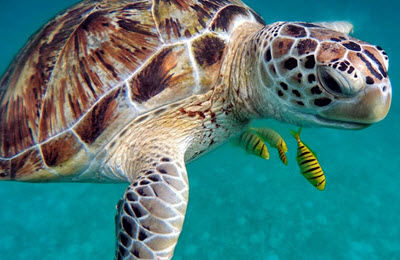
Sea turtles live in almost every ocean throughout the world. They nest and lay their eggs on tropical and subtropical beaches. Some species sometimes enter mangrove forests to lay their eggs there, where they are better protected. They migrate long distances to feed, often crossing entire oceans. These ancient creatures have been on Earth for over 100 million years, surviving the dinosaurs when they became extinct 65 million years ago. Sea turtles are a group of reptiles found in all oceans except in the polar area.
Out of 7 known species of sea turtles, six are critically endangered. The main factors that decrease the number of sea turtles are poaching, loss of nesting or feeding areas, accidental catch, ocean pollution and weather changes or, in other words, global warming.
Among other threats these marine reptiles face are entanglement, habitat loss, and consumption of their eggs and meat.

There are some positive developments to report. The number of nests reported on some beaches has skyrocketed in later years due to protection efforts taken about 10-15 years ago. More and more beach communities learn that they can earn more money by protecting their turtles than they can by harvesting their eggs and the adult turtles for meat.
These reptiles spend their entire lives at sea, except when adult females come ashore to lay eggs several times per season every two to five years.
It is estimated that only one hatchling in a thousand will make it to adulthood. Whether it’s the treacherous journey from nest to ocean or the predatory dangers of the open sea, it’s a cruel world for these youngsters.
During incubation, sex is determined by the temperature of the surrounding environment. Warm temperatures produce more female hatchlings, whereas cooler temps result in males.
Most scientists recognize two families of sea turtles:
- Family Cheloniidae includes all sea turtles with scutes (horny plates) covering their shells.
- Family Dermochelyidae are scuteless turtles with only one modern species: the leatherback turtle. A leatherback turtle is covered with leathery skin. It is the only marine turtle whose backbone is not attached to the inside of its shell.
Sea turtle species
- Green Sea Turtle (Chelonia mydas): Known for its distinct green fat beneath its shell, this turtle primarily feeds on seagrasses and algae. They are commonly found in tropical and subtropical waters.
- Loggerhead Sea Turtle (Caretta caretta): Recognizable by its large head and reddish-brown shell, loggerheads mainly consume jellyfish, conchs, and crabs.
- Leatherback Sea Turtle (Dermochelys coriacea): The largest of all sea turtles, the leatherbacks are unique due to their leather-like shell and deep-diving habits. Their diet mainly consists of jellyfish.
- Hawksbill Sea Turtle (Eretmochelys imbricata): With a bird-like beak and beautiful patterned shell, they predominantly feed on sponges in coral reefs.
- Kemp’s Ridley Sea Turtle (Lepidochelys kempii): Known as the rarest species, they have a circular shell and prefer crabs.
- Olive Ridley Sea Turtle (Lepidochelys olivacea): Similar to Kemp’s but larger, these turtles are famous for their synchronized nesting in large numbers, termed “arribadas.”
- Flatback Sea Turtle (Natator depressus): Found exclusively in the waters of Australia, these turtles have a flattened shell and primarily feed on sea cucumbers and jellyfish.
Fun facts about sea turtles:
 Sea turtles walk slowly on the ground because their flippers are adapted for swimming and not walking. They are excellent swimmers that can travel large distances. The leatherback turtle can travel 12,000 miles from Indonesia to Oregon.
Sea turtles walk slowly on the ground because their flippers are adapted for swimming and not walking. They are excellent swimmers that can travel large distances. The leatherback turtle can travel 12,000 miles from Indonesia to Oregon.- Sea turtles are very old organisms. They have lived on Earth for more than 220 million years. They managed to survive weather changes which killed the dinosaurs.
- Sea turtles don’t have teeth, but their mouths are adapted to each type of food they normally eat. Green Sea Turtle is vegetarian and eats sea grass, while other turtles eat crabs, clams, jellyfish, and sea cucumbers.
- Sea turtles can live from 70-80 years.
- Their body is protected with an upper shell called the carapace.
- Unlike land turtles, sea turtles can’t hide their heads and legs inside their shell. That makes them more vulnerable when they come in contact with predators.
- Sea turtles spend most of their life in the ocean. Females can be seen on the beaches only during nesting season.
- During nesting season, females will return to the same beach where she was born. She will find the right beach even after 30 years of absence.
- Turtle lays eggs in the holes in the sand. These nests can’t be recognized easily because the turtle covers them with additional layers of sand. Depending on the species, each nest contains between 60-200 eggs.
- Temperature determines the gender of the baby turtles. Females will be born if the egg’s temperature is high, and males if the egg’s temperature is low.
Summary
From leatherbacks to loggerheads, six of the seven sea turtles are threatened or endangered at the hands of humans. Sadly, the fact is that they face many dangers as they travel the seas including accidental capture and entanglement in fishing gear, the loss of nesting and feeding sites to coastal development, poaching, and ocean pollution, including plastic.
